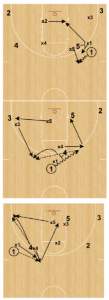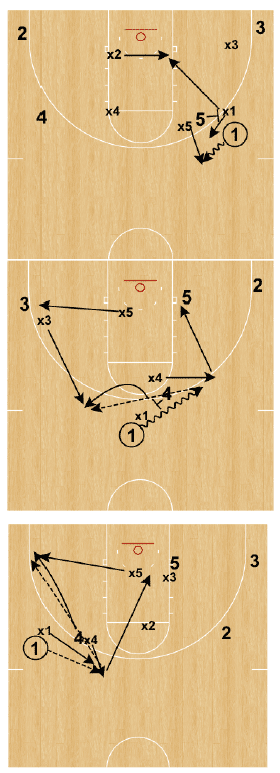
University of Maine Men’s Assistant Coach Zak Boisvert has assembled some notes from Brad Stevens at the 2016 Brayden Carr Coaches Clinic. The Brayden Carr Foundation is a non-profit charitable organization that works to raise money for children with seizure conditions. The charity was established by Rhode Island assistant coach Jim Carr and his wife Natalie after their son died tragically in May 2011. You can find out more about the charity at this link.
He has an outstanding site with posts on various coaching topics at www.pickandpop.net
His You Tube channel has several videos with various types of man to man plays, zone sets, and inbounds plays. You can subscribe to receive an update when he posts a new video Zak Boisvert You Tube Channel
You can follow him on Twitter at this link: @ZakBoisvert
Brad Stevens, Boston Celtics
-All coaches are bound together. It’s a brotherhood and we should always be looking to help one another.
-I spent 13 years at Butler University in Indianapolis and it was the greatest learning experience I could have ever asked for.
-I went to Butler as a volunteer support staffer and quickly learned that I knew nothing. They taught me so much more than I thought there was to know.
-Look at the things you do and ask why you do it. Is it the best way or the way you’re used to doing it? Are we doing it because it’s the right way or because we think we’re supposed to be doing it that way?
• Adjusted shoot around time because his players liked it more later in the day.
-I learned the importance of running a condensed, efficient practice. He worked so hard to create a practice plan that covered what needed to be covered, but was as concise as possible to be respectful of his players’ time.
• Abraham Lincoln: “I apologize for the length of this letter. I did not have time to write a short one.”
• The importance of rest & recovery: clear mind, fresh legs.
-As a coach, you are what you emphasize.
-Your first meeting with the team is incredibly important.
• What is important to winning?
• Dominate effort plays.
• Get good shots.
-You will make tweaks to your systems. You will run different stuff from year-to year, but there should be a certain amount of absolutes built into your philosophy that you won’t/can’t budge on.
-Vitally important as a coach: Perspective and balance. Your health/family/wellbeing is more important than the next game. I encourage all coaches to read the Urban Meyer piece on Bleacher Report entitled, “I’m Not the Lone Wolf.”
-I love watching football coaches. Their ability to get 100 people on the same page with tempo is astounding.
-Books I recommend:
1. Grit (Angela Duckworth)
2. Legacy (James Kerr)
3. Mindset (Carol Dweck)
-James Kerr (Legacy): Successful leaders look beyond their own field to discover new approaches, learn best practices and push the margins.
-Don’t focus on trophies, focus on getting better.
• Get rid of the emotional roller-coaster that comes with fixating on results.
• Fall in love with the pursuit.
-Our goal is a championship. Anything less would be disrespectful to the organization we represent. While that’s our goal, we’re focused on the process and getting better.
-We crafted our entire defense (& recruiting philosophy) over how we hedged pick & rolls.
• Hard hedged all ball screens.
• The way we taught defense started with the hedge.
• We recruited to the way we defended. We wouldn’t recruit bigs that couldn’t move.
-By the way…If you’re more athletic and can switch everything, throw everything else out. Switch everything and enjoy winning.
-We created chaos with the athleticism of our bigs’ hedging. We were elite defensively when our guards were athletic too (Shawn Vanzant, Ronald Nored) and could get into the ball and direct/impact it.
-The science of the hedge:
• Hand on screener’s back.
• Parallel with the sideline / perpendicular with half court line.
• 2 hard steps up the court.
• Listening for guard’s “Back” call as he moved underneath you.
• Running back to the lane and being directed by the guys positioned in help.
-As we hedge that side pick & roll, the other 3 defenders move into a zone—no longer matched to a person.
• We’re “Muhammad Ali-Ready.” On our toes, ready to pounce.
• Ready to fly out.
• Know who the player you’re closing-out to and what they do. That’s the importance of personnel awareness in scouting. Because of how often we’re zoned up on the weak side, you need to know the strengths of everyone on the other team, not just your match up.
Diagrams created with FastDraw

-Versus a spread pick & roll, our “Ultimate Helper” on the roll is the weak side corner defender (rather than the single-side bump guy).
If the single-side bump (x3) gets pulled in on 5’s roll, it’s too easy of a play for the offense to throwback to 3 on a lift.
“Ultimate Helper” meets the roll in front of the charge circle. In this scenario, x4 would start inching out as the ball is being dribbled at him and would take the first pass to the weakside (either to 2 or 4).
-Will rotate to a great pick & pop on a middle pick & roll
-Versus the shooting 4-man on a side ball screen: “X Switch.”
-Drill: defense x’s the first side ball screen. Offense skips it to the corner off the second ball screen. X1 takes the first pass out.

-“Contain Blitz” concept:
• Guard: don’t get beat corner.
• Both: don’t get split middle.
• On pass, big can leave.
• Make sure the pass out has to be made over outstretched arms.
-At Butler, we wanted to be absolutely chaotic on the ball. We wanted to utilize the athleticism of our bigs.
-Every time in which I thought we were really bad defending the pick & roll at Butler, I would go back and watch the tape and I’d always end with the same conclusion, the two guys on the basketball weren’t good enough/didn’t create enough chaos.
-Weakside nail defender: we don’t want you on the nail (we’re pulled too far over that way). We just want them thinking you’re at the nail.
-The first aspect of a closeout is to do so knowing the tendency of the man you’re closing out to. Is he a shooter? Non-shooter? Baseline rip & go guy?
-We ideally want to hear the pick & roll coverage 3 times by our bigs, but we know it doesn’t always work that way.
-4-on-4 Drill: The four offensive players stationed around the perimeter swing the ball around. The coach calls out one of the defensive players’ names and he sprints to touch half court and sprints to come back into the play. As soon as the coach calls the defensive player’s name, the drill becomes live (offense trying to get a layup).
-In disadvantage situations, what are our priorities?
1. Basket
2. Ball
3. Great Shooter
-Think about who is in your area (that you might be closing out on) in a disadvantage situation. We’re taking away layups and we’re stopping the ball. Ultimately what we want is a jump shot taken by the worst shooter on the court.
-A game great plan can do the job for all 40 minutes in the college game. In the NBA, the great players will expose your game plan, no matter how good it is. You have to have your adjustments and contingency plans.
-Good players will beat good pick & roll defense.
-I cannot stress how important it is to know the opposing team’s personnel. If guys want to call that analytics, sure, I’m into analytics.
-Whose call on “Veer” (late switch)? Out of convenience, it’s the guard’s call. He knows when he’s beat.
ICEing the Pick & Roll
-Because of the extra space inside the 3-point line in the NBA (compared to college), the onus really falls on the guards in your ICE.
-Guards:
• Straddle leg
• Win foot race with the ball
• On dribble pick-up, 2 hands high to deflect or delay the pass.
-Bigs:
• The higher you can be, the better (but only to an accurate level of your mobility).
• BIG inside hand low taking away the pocket pass to the screener rolling versus the ICE.
• Dropping appropriately and returning when pass is made or the guard squares the ball up.
You can read the remainder of the notes and also download a pdf at this link: Pick and Pop Brad Stevens Clinic Notes






